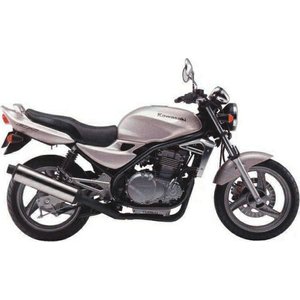Kawasaki ER-5 Twister (1997–2000): A Timeless Twin for Everyday Riders
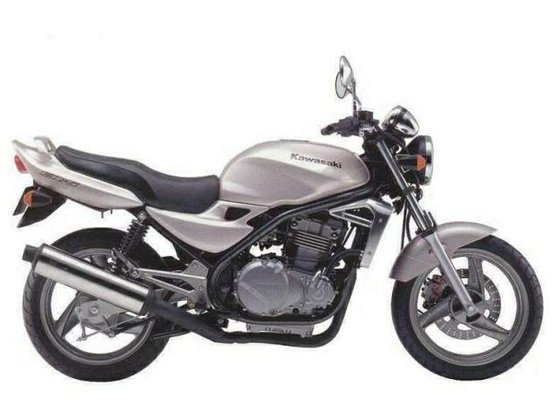
Introduction
The Kawasaki ER-5 Twister, produced from 1997 to 2000, is a motorcycle that embodies simplicity, reliability, and approachability. Designed as a naked roadster, it catered to new riders, commuters, and anyone seeking an unfussy machine that prioritizes function over flair. Built around the proven parallel-twin engine from Kawasaki’s GPZ500S, the ER-5 offered a balanced mix of performance and practicality. Even today, its straightforward design and forgiving nature make it a compelling choice in the used market.
Let’s take a closer look at what makes this understated twin tick—and why it still holds appeal decades later.
Design & Ergonomics
The ER-5’s design is quintessentially ’90s: a no-nonsense roadster with a rounded fuel tank, minimalist bodywork, and a neutral riding posture. The steel-tube cradle frame gives it a sturdy yet lightweight foundation (174 kg dry / 383 lbs), while the 780 mm (30.7 in) seat height ensures accessibility for shorter riders. That said, some specs note an 815 mm (32.1 in) seat height, suggesting minor variations across markets or model years. Either way, the narrow seat and low center of gravity make it easy to plant both feet at stops.
Color options were limited to bold primaries like red, green, and blue, typical of Kawasaki’s “screaming green” era. The 16-liter (4.2-gallon) fuel tank is sculpted for knee grip, though its plastic construction feels utilitarian. Instrumentation is basic—analog speedo and tach with neutral and indicator lights—but legible at a glance.
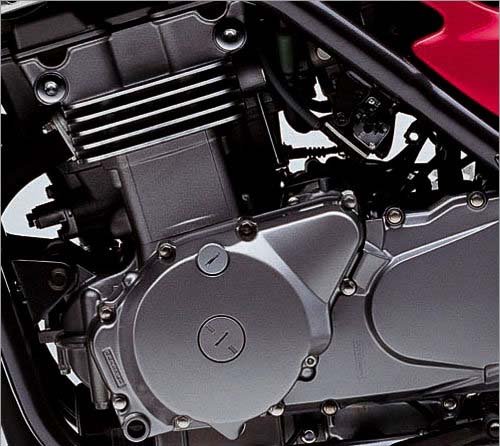
Rider Comfort:
The upright handlebars and mid-mounted footpegs create a relaxed riding triangle, ideal for city commutes or weekend rides. The seat padding is adequate for short trips but might feel firm after an hour. Wind protection is nonexistent, as expected from a naked bike, so highway speeds can feel breezy.
Performance & Engine Character
At the heart of the ER-5 lies a liquid-cooled, 499cc parallel-twin engine with DOHC and 4 valves per cylinder. Output figures vary slightly across sources, but most agree on 50 HP (36.5 kW) at 8,500–9,000 RPM and 45 Nm (33.2 lb-ft) of torque at 7,000 RPM. These numbers might seem modest, but the twin’s broad powerband delivers punchy low-end grunt, making it forgiving for beginners.
Throttle Response:
The twin’s character is smooth and linear, with minimal vibrations thanks to its 180-degree crankshaft. Carbureted by twin 34mm Keihin CVK units, it’s responsive without being twitchy. The 6-speed gearbox shifts cleanly, though the clutch action is light enough for stop-and-go traffic.
Acceleration & Top Speed:
- 0–100 km/h (0–62 mph): ~5 seconds (quicker than many peers in its class).
- Top Speed: Sources cite 160–185 km/h (99–115 mph), likely depending on rider weight and tuning. At highway speeds, the engine feels relaxed at 6,000 RPM in sixth gear.
Fuel Efficiency:
With a claimed 18.5 km/l (43.5 mpg), the ER-5 sips fuel. Even aggressive riding rarely drops it below 15 km/l (35 mpg), granting a 240–270 km (150–170 mi) range per tank.
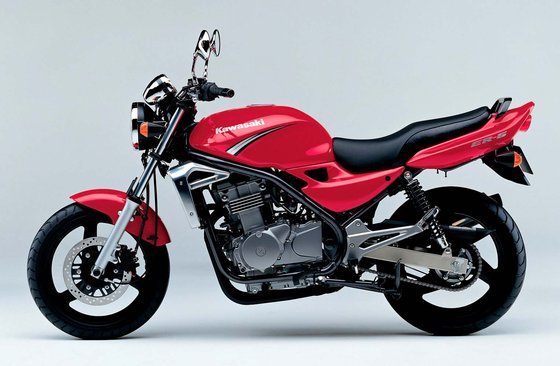
Handling & Ride Dynamics
The ER-5’s chassis prioritizes stability over sportiness. The 1,430 mm (56.3 in) wheelbase and conservative steering geometry make it predictable, if not razor-sharp.
Suspension:
- Front: 37mm telescopic forks with 125 mm (4.9 in) of travel. Plush over bumps but prone to dive under hard braking.
- Rear: Dual shocks with 5-way preload adjustment. Stiffen them for solo rides; soften for passengers.
Brakes:
The single 280mm front disc with a 2-piston caliper offers adequate stopping power, though it lacks bite compared to modern setups. The rear drum brake (160mm) requires a firm press—a relic even in the ’90s.
Tires:
Stock rubber includes a 110/70-17 front and 130/70-17 rear. These narrow tires enhance flickability but limit cornering grip by today’s standards.
At the Handlebar:
The ER-5 feels nimble in urban traffic, with a tight turning radius and light steering. On twisty roads, it’s competent but not thrilling—the soft suspension and basic tires encourage a relaxed pace.
Competition
The ER-5 faced stiff rivalry in the 500cc naked segment. Here’s how it stacked up:
- Suzuki GS500E:
- Air-cooled parallel twin, 48 HP.
- Lighter (168 kg) but vibrates more at high RPM.
- Drum rear brake until 2004.
-
Verdict: The ER-5’s liquid cooling and smoother power delivery give it an edge.
-
Honda CB500:
- 57 HP inline-twin, sharper handling.
- Higher seat (785 mm) and costlier maintenance.
-
Verdict: The CB500 is sportier, but the ER-5 is cheaper to own.
-
Yamaha XJ600S Seca II:
- 76 HP inline-four, heavier (209 kg).
- Complex for beginners; thirstier.
- Verdict: The ER-5 wins on simplicity and fuel economy.
Why Choose the ER-5?
It strikes a middle ground: approachable for novices, economical for commuters, and robust enough for seasoned riders seeking a hassle-free machine.
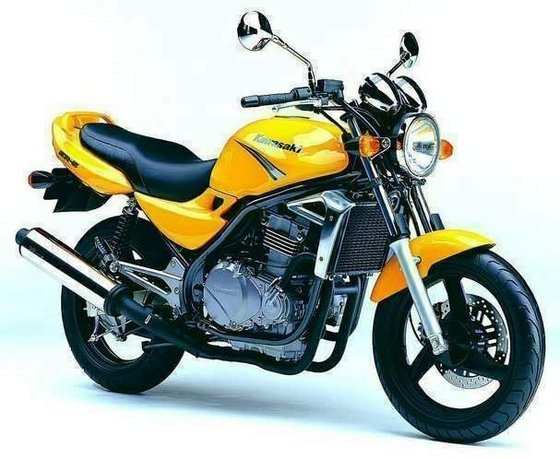
Maintenance & Ownership
The ER-5’s mechanical simplicity makes it a dream to maintain. Here are key considerations:
Engine Care:
- Oil Changes: Use 3.0L of SAE 10W-40 (API SE or higher) every 5,000 km.
- Valve Clearances: Check every 10,000 km:
- Intake: 0.13–0.18 mm (0.005–0.007 in).
- Exhaust: 0.18–0.23 mm (0.007–0.009 in).
- Coolant: Replace every 2 years (1.7L capacity).
Brake System:
- Front Disc: Upgrade to sintered pads (available at MOTOPARTS.store) for better bite.
- Rear Drum: Clean regularly to prevent sticking.
Chain & Sprockets:
- Stock gearing is 17/42 teeth. A 16T front sprocket improves acceleration.
- Replace the 106-link chain when stretched beyond 2–3% slack.
Tire Pressures:
- Front: 2.25 bar (33 psi).
- Rear: 2.5 bar (36 psi).
Common Upgrades:
- Suspension: Progressive fork springs and aftermarket shocks enhance ride quality.
- Exhaust: A slip-on muffler (like our MOTOPARTS.store offerings) adds character without rejetting.
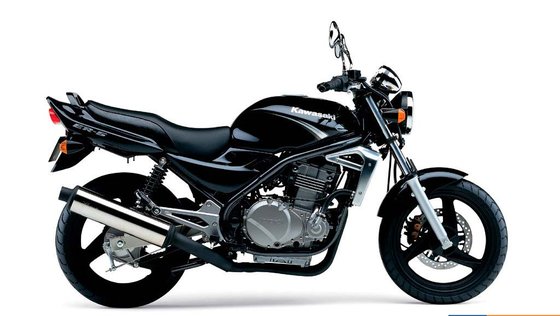
Final Thoughts
The Kawasaki ER-5 Twister isn’t a motorcycle that demands attention. It won’t dominate track days or turn heads at cafes, but it excels as a dependable daily companion. Its liquid-cooled twin remains smooth and durable, while the lightweight chassis forgives rookie mistakes. For riders seeking an affordable, low-maintenance machine that’s equally at home in traffic or on backroads, the ER-5 is a hidden gem.
And when it’s time to refresh your ER-5, MOTOPARTS.store has you covered—from OEM-spec brake pads to performance upgrades that breathe new life into this classic twin.
Specifications sheet
| Engine | |
|---|---|
| Stroke: | Four-stroke |
| Max power: | 37 kW | 50.0 hp |
| Max torque: | 45 Nm |
| Fuel system: | 2x 34mm Keihin CVK carburetors |
| Max power @: | 8500 rpm |
| Displacement: | 498 ccm |
| Max torque @: | 7000 rpm |
| Bore x Stroke: | 74 x 58 mm (2.9 x 2.3 in) |
| Configuration: | Inline |
| Cooling system: | Liquid |
| Compression ratio: | 9.8:1 |
| Number of cylinders: | 2 |
| Dimensions | |
|---|---|
| Wheelbase: | 1430 mm (56.3 in) |
| Dry weight: | 180 |
| Seat height: | 815 mm (32.1 in) |
| Ground clearance: | 165 mm (6.5 in) |
| Fuel tank capacity: | 17 L (4.5 US gal) |
| Drivetrain | |
|---|---|
| Final drive: | chain |
| Chain length: | 106 |
| Transmission: | 6-speed |
| Rear sprocket: | 42 |
| Front sprocket: | 17 |
| Maintenance | |
|---|---|
| Rear tire: | 130/70-17 |
| Engine oil: | 10W40 |
| Front tire: | 110/70-17 |
| Break fluid: | DOT 4 |
| Spark plugs: | NGK DR9EA or NGK DR9EIX |
| Spark plug gap: | 0.7 |
| Coolant capacity: | 1.7 |
| Forks oil capacity: | 0.63 |
| Engine oil capacity: | 3.0 |
| Engine oil change interval: | Every 5000 km or 2 years, whichever comes first |
| Valve clearance (intake, cold): | 0.13–0.18 mm |
| Valve clearance (exhaust, cold): | 0.18–0.23 mm |
| Recommended tire pressure (rear): | 2.5 bar (36 psi) |
| Recommended tire pressure (front): | 2.25 bar (33 psi) |
| Chassis and Suspension | |
|---|---|
| Frame: | Steel-tube cradle |
| Rear brakes: | 160 mm drum |
| Front brakes: | Single 280 mm disc, 2-piston caliper |
| Rear suspension: | Dual rear shocks with 5-way adjustable preload |
| Front suspension: | 37 mm telescopic fork |
| Rear wheel travel: | 114 mm (4.5 in) |
| Front wheel travel: | 125 mm (4.9 in) |



